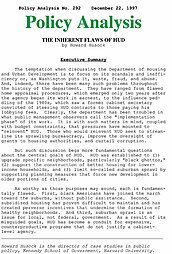But such discussion begs more fundamental questions about the central goals of HUD. HUD was established to (1) upgrade specific neighborhoods, particularly “black ghettos,” (2) support the construction of better housing for lower-income households, and (3) limit so-called suburban sprawl by supporting planning measures that force new development in older portions of cities.
As worthy as those purposes may sound, each is fundamentally flawed. First, black Americans have joined the march toward the suburbs, without public assistance. Second, subsidized housing has proven difficult to maintain and has created perverse incentives that undermine the formation of healthy neighborhoods. And third, suburban sprawl is an issue for local, not federal, government. As a result of its misguided goals, HUD has become a conduit for expensive, counterproductive programs that do not justify a cabinet-level agency.

